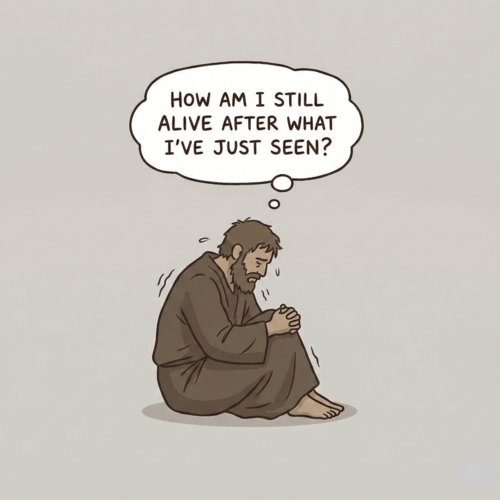Did Paul Walk the Via Appia on His Final Journey to Rome?
Picture this: chains clinking with each step, a Roman prisoner walks along one of history’s most famous roads. But this isn’t just any prisoner—it’s the Apostle Paul, and the road beneath his feet is the legendary Via Appia, the “Queen of Roads” that connected Rome to the wider world. As Paul made his final journey to Rome around 60 AD, he likely travelled this very route, transforming what began as a military highway into something far more significant for the spread of Christianity.
THE VIA APPIA: ROME’S STRATEGIC MASTERPIECE
When Roman censor Appius Claudius Caecus ordered the construction of the Via Appia in 312 BC, he couldn’t have imagined this strategic military road would one day serve as a highway for the gospel. This engineering marvel stretched 18 feet wide and was paved with massive polygonal stones so perfectly fitted that grass still struggles to grow between them over 2,000 years later.
The road was built for empire—a 366-mile lifeline connecting Rome to the port of Brindisi, where ships sailed to Greece, Asia Minor, and the eastern Mediterranean. For centuries, Roman legions marched along its stone surface, merchants transported goods, and messages carried news across the empire. The Via Appia embodied Roman power, efficiency, and the ability to connect distant territories to the heart of the empire.
PAUL’S FINAL JOURNEY: FROM PRISONER TO PREACHER
When Paul arrived at the Italian port of Puteoli in 60 AD, he was technically a prisoner awaiting trial before Caesar. Yet his journey to Rome tells a different story. After finding fellow believers in Puteoli and spending a week with them, Paul likely joined the Via Appia at Capua, beginning the final 140-mile stretch to Rome.
As a Roman citizen, Paul wouldn’t have been treated as a common criminal. His journey would have been measured, allowing for proper rest stops at the various way stations along the route. This wasn’t a forced march—it was a procession that would soon become one of the most significant arrivals in Christian history.
TWO ENCOURAGING ENCOUNTERS
As Paul travelled northwest toward Rome, two extraordinary encounters awaited him that would transform his final journey from a mere legal formality into a powerful moment of encouragement and fellowship.
Forum of Appius: The First Welcome: At Forum of Appius, roughly 43 miles from Rome, something remarkable happened. A group of Roman Christians had travelled from the capital specifically to meet Paul. These believers, having heard of his approach, left the comfort of their city to walk into the countryside and greet this fellow Christian who had written them such a profound letter years earlier.
Imagine the scene: Paul, perhaps weary from travel and uncertain about his future, suddenly encountering familiar faces—fellow believers who had made the deliberate choice to seek him out. This wasn’t coincidence; it was Christian community in action.
Three Taverns: Courage Renewed: Ten miles closer to Rome, at a way station called Three Taverns, another group of Christians joined the procession. By this point, Paul was traveling with not just his guards and companions, but with an ever-growing entourage of Roman believers.
The Bible tells us that when Paul saw these brothers and sisters, “he thanked God and took courage.” This simple phrase captures something profound: even apostles needed encouragement. The Via Appia had become more than a road—it had become a pathway of fellowship, where the Christian community demonstrated its unity and support for one of its most important leaders.
THE VIA APPIA AS CHRISTIANITY’S FIRST HIGHWAY
Paul’s journey along the Via Appia illustrates a crucial truth about the spread of Christianity: the gospel travelled along the same routes that held the Roman Empire together. The road system that Caesar used to maintain political control became the infrastructure that enabled the Christian message to spread with unprecedented speed and efficiency.
The Via Appia was particularly strategic because it connected Rome to the eastern Mediterranean, where Christianity first took root. Ships from Ephesus, Corinth, and other cities with established Christian communities docked at Brindisi, and from there, the Via Appia provided a direct route to Rome. Paul’s letter to the Romans had likely reached them along this very route years earlier.
The roads offered more than mere transportation—they provided the framework for a communication network. Christian letters, couriers, and traveling teachers could move safely and efficiently across the empire. The Pax Romana, or Roman peace, meant that missionary journeys that would have been impossible in previous centuries could now be undertaken with relative safety.
FROM ROAD TO NETWORK: THE GOSPEL’S INFRASTRUCTURE
The Via Appia’s role in Christianity extends far beyond Paul’s single journey. As the Christian message spread westward, the road became a vital link in a growing network of believers. The same infrastructure that enabled Roman soldiers to march quickly to put down rebellions now enabled Christian teachers to travel from community to community, strengthening the early church.
This network effect was crucial for the young Christian movement. When Christian communities in Rome faced persecution or doctrinal questions, they could send messages along the Via Appia to more established churches in the east. When teachers like Paul needed support or encouragement, communities could coordinate their efforts, as they did when two groups of believers met him at Forum of Appius and Three Taverns.
The strategic Importance of reaching Rome cannot be overstated. As the empire’s capital, Rome was the ultimate destination for any movement with universal aspirations. By traveling the Via Appia to Rome, Paul was following the same path that led to the heart of the known world. From Rome, the Christian message could spread to every corner of the empire.
A ROAD BUILT FOR EMPIRE, USED BY GOD
Perhaps the most remarkable aspect of Paul’s journey on the Via Appia is how it demonstrates God’s ability to use human infrastructure for divine purposes. The Romans built this road to facilitate military conquest and maintain political control. Yet it became the pathway for a message that would ultimately transform the very empire it was designed to serve.
Walking the Via Appia today—and significant portions of the ancient road remain intact—you can still see the massive stones that supported not just Roman legions, but the footsteps of early Christian missionaries. The road that once carried news of military victories later carried the message of a different kind of victory: the triumph of God’s love over human power.
The encounters at Forum of Appius and Three Taverns remind us that the Christian journey is never meant to be travelled alone. Just as these early believers left the comfort of their city to encourage Paul, we too are called to support and strengthen one another. The Via Appia may have been built for empire, but on one crucial journey in 60 AD, it became a pathway of fellowship, encouragement, and the advancement of God’s kingdom.
THE VIA APPIA: RELATED FAQs
How long did it take Paul to walk the Via Appia from Puteoli to Rome? Paul’s journey from Puteoli to Rome would have taken approximately 5-7 days, covering roughly 20-25 miles per day along the Via Appia. As a Roman citizen and prisoner with legal status, Paul would have been allowed proper rest stops at the numerous way stations along the route. The journey was likely unhurried, allowing time for the planned meetings with Christian communities along the way.
- What other famous biblical figures may have travelled the Via Appia? While Paul’s journey is the most documented, other early Christian leaders likely used the Via Appia when traveling to or from Rome. According to tradition, the apostle Peter may have travelled this route when he came to Rome, and later Christian leaders like Bishop Ignatius of Antioch would have used it on their way to martyrdom in Rome. The road was the standard route for anyone traveling from the eastern Mediterranean to Rome.
- Did Paul’s guards allow him to preach along the Via Appia during his journey? Given Paul’s legal status and the fact that he was under relatively lenient house arrest rather than harsh imprisonment, his guards likely allowed him considerable freedom to interact with people along the route. The fact that Christian communities were able to meet him openly suggests Paul wasn’t severely restricted in his movements or conversations. This was typical for Roman citizens awaiting trial who were considered lower-risk prisoners.
Why didn’t Paul travel directly from Puteoli to Rome by boat rather than taking the longer land route? While small boats could theoretically have carried Paul from Puteoli to Rome via the coast, the Via Appia was actually the more reliable and safer option. The final stretch to Rome by sea involved navigating the mouth of the Tiber River, which was notoriously difficult and dangerous. The Via Appia was specifically designed as the primary route between the port of Puteoli and Rome, making it the logical choice for official Roman business.
- How did the Christian communities in Rome know exactly when and where to meet Paul? The early Christian communities had remarkably efficient communication networks, likely using the same Roman postal system and trade routes that connected the empire. News of Paul’s arrival at Puteoli would have been sent ahead to Rome, and the Christian community there would have known the standard timetable for travel along the Via Appia. The specific meeting locations at Forum of Appius and Three Taverns were well-known waypoints that made perfect rendezvous spots.
- What happened to the Via Appia after Paul’s journey? How did it continue to impact Christianity? The Via Appia continued to serve as a major artery for Christian growth, with numerous early Christian communities establishing themselves along its route. By the 3rd and 4th centuries, the road became famous for its Christian catacombs, including the famous Catacombs of San Callisto and San Sebastiano. The road eventually became a pilgrimage route for Christians wanting to visit the sites of early Christian martyrs buried along its path.
Can we visit the places where Paul met the Roman Christians today? While the exact locations of Forum of Appius and Three Taverns are debated by archaeologists, both were generally located in the area of modern-day Cisterna di Latina and Tre Taverne respectively. The Via Appia Antica is remarkably well-preserved, and visitors can walk on the same stones Paul likely walked on. The Parco Regionale dell’Appia Antica in Rome protects a significant portion of the ancient road, and several of the original mile markers and tombs remain visible along the route.
THE VIA APPIA: OUR RELATED POSTS
Editor's Pick

The Throne-Room Vision: Who Did Isaiah See?
The scene is unforgettable: Isaiah stands in the temple, and suddenly the veil between heaven and earth tears open. He [...]

The Angel of the Lord: Can We Be Certain It Was Christ All Along?
Throughout the Old Testament, a mysterious figure appears: the Angel of the LORD. He speaks as God, bears God’s name, [...]
SUPPORT US:
Feel the Holy Spirit's gentle nudge to partner with us?
Donate Online:
Account Name: TRUTHS TO DIE FOR FOUNDATION
Account Number: 10243565459
Bank IFSC: IDFB0043391
Bank Name: IDFC FIRST BANK






